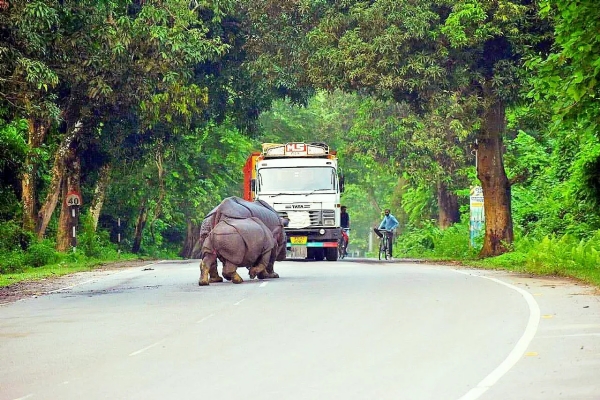Assam CM shares concerns on social awareness about #Rhino conservation with a disturbing footage
"Rhinos are our special friends; we"ll not allow any infringement on their space. In this unfortunate incident at Haldibari, the Rhino survived; vehicle intercepted and fined," tweeted Assam CM Himanta Biswa Sarma.
Total Views | 137
In a recent video that has went viral on social media as the Assam CM, Himanta Biswa Sharma himself shared and condemned the incident, a Rhino is seen hit by running truck. Assam Chief Minister Himanta Biswa Sarma condemned the incident at Haldibari where a vehicle mauled a rhino on a road. Himanta informed that the rhino has survived the accident and the vehicle has been intercepted and fined.

"Rhinos are our special friends; we'll not allow any infringement on their space. In this unfortunate incident at Haldibari, the Rhino survived; vehicle intercepted and fined," tweeted Himanta. "Meanwhile in our resolve to save animals at Kaziranga, we're working on a special 32-km elevated corridor," tweeted further. On Sept 22, Assam Chief Minister Himanta Biswa Sarma, along with Sadhguru Vasudev, opened the Kaziranga National Park for tourists for this season.
Chief Minister Sarma, on the day, also unveiled three rhino statues at Mihimukh in Kaziranga along with Vasudev. These rhino statues have been created using the ashes collected from burning rhino horns. It may be noted that on Sept 22, last year, the Assam government made history when a stockpile of 2,479 rhino horns were consigned to flames to send across a strong message to the poachers and illegal horn traders that rhino horns have no medicinal value. The rhino statues thus created are an attempt to immortalize the efforts and dedication of those who selflessly protect Assam's pride, the great one-horned rhinoceros.
According to the data of the World Wildlife Fund and Nature, the greater one-horned rhino (or “Indian rhino”) is the largest of the rhino species. Once widespread across the entire northern part of the Indian sub-continent, rhino populations plummeted as they were hunted for sport or killed as agricultural pests. This pushed the species very close to extinction and by the start of the 20th century, around 200 wild greater one-horned rhinos remained.
The WWF, however, also mentions that the recovery of the greater one-horned rhino is among the greatest conservation success stories in Asia. The organization owes he success of the Rhino conservation project to strict protection and management from Indian and Nepalese wildlife authorities, the greater one-horned rhino was brought back from the brink. Today populations have increased to around 3,700 rhinos in Northeastern India and the Terai grasslands of Nepal.
The second-largest land mammal on earth, rhinos are herbivorous animals that are oe of the strongest in the animal kingdom. With the natural ability to reach a weight of over 3 tonnes and a height of more than 6.5 feet, rhinos are one of the strongest animals on the planet. Add to it their speed rate of more than 30 mph and powerful horns that can grow to reach 39 inches in length, rhinos are capable of easily taking on any predator.
The greater one-horned rhino is identified by a single black horn about 8-25 inches long and a grey-brown hide with skin folds, which gives it an armor-plated appearance. The species is solitary, except when adult males or rhinos nearing adulthood gather at wallows or to graze.
Rhinos share their homes with other valuable plants and animals. When we protect greater one-horned rhinos, we also help protect these other species. These rhinos are also a symbol of national pride in the countries where they are found, which inspires environmental protection among local communities. These communities also benefit from the revenue generated through rhino ecotourism.
---
Bharati Web
Mes, Pune







